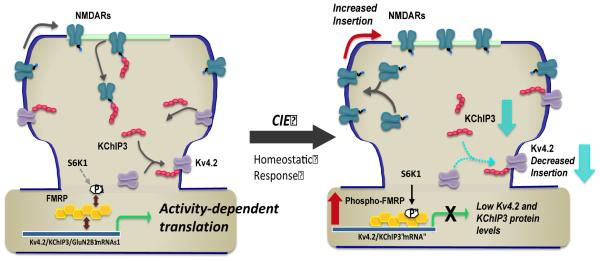Figure 7.
Model of chronic ethanol induced homeostatic bidirectional changes in expression of NMDA and Kv4.2 channels, and the role of KChIP3 and FMRP in this activity-dependent process. Left panel depicts regulation of the surface expression of NMDA receptors and Kv4.2 via a coupled process involving the multifunctional protein KChiP3. As an accessory protein to Kv4.2, KChiP3 association with Kv4.2 promotes it’s trafficking and enhances its surface expression. In contrast, it functions as a negative modulator of NMDA receptor function and surface expression. The activity dependent expression of all these proteins is controlled by FMRP, which functions as a negative regulator of translation. Right panel depicts homeostatic adaptations in response to chronic attenuation of synaptic activity associated with alcohol exposure. These changes include a increase in the surface expression of GluN2B-containing NMDA receptors and reduction in the surface expression of Kv4.2 channels. This bidirectional change may be mediated, at least in part, by reduction in expression of KChIP3. In addition, these homeostatic changes are dependent on enhanced phosphorylation of S499 of FMRP (via S6K1) that in turn promotes inhibitory binding of mRNA transcripts including Kv4.2 and KChIP3 mRNA. While ethanol exposure is also associated with a reduction in GluN2B binding to FMRP, the mechanism responsible for this reduction is not clear and likely involves additional regulatory processes.

